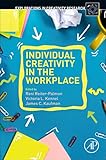Individual creativity in the workplace / edited by Roni Reiter-Palmon, Victoria L. Kennel, James C. Kaufman.
Publisher: London : Academic Press, 2018Description: xxiii, 397 pages : illustrations ; 23 cmContent type:- text
- unmediated
- volume
- 9780128132388
- HD 53 .In27 2018
| Item type | Current library | Collection | Call number | Copy number | Status | Date due | Barcode | |
|---|---|---|---|---|---|---|---|---|
 Circulation
Circulation
|
DLSU-D HS Learning Resource Center Circulation | Circulation | HD 53 .In27 2018 (Browse shelf(Opens below)) | 1 | Available | 3SHS2019000952 |
"Explorations in creativity research"
Contents: Intro; Title page; Table of Contents; Copyright; Dedication; Contributors; Individual Creativity in the Workplace: An Introduction; Section 1: Creativity and Innovation: Larger Concepts; Chapter 1: Moving From Creativity to Innovation; Abstract; Defining Creativity and Innovation; Idea Evaluation and Creative Forecasting; Research on Idea Selection; Getting Ideas Implemented in the Organizational Context; Practical Recommendations for the Organizational Context; Concluding Remarks; Chapter 2: The Fuzzy Front-End? How Creativity Drives Organizational Innovation; Abstract
Contents: Introduction-Change and UncertaintyWhat Is Innovation?; Why Is Innovation Important to Organizations?; Change as the Driver of Innovation; The Stages of Innovation; Creativity: The Fuzzy Front-End of Innovation?; Managing Creativity in the Process of Innovation; Concluding Thoughts; Chapter 3: An Integrated Model of Dynamic Problem Solving Within Organizational Constraints; Abstract; Acknowledgments; Introduction; The Creative Process: Two Paths or One?; Dynamic Problem Solving Within Organizational Constraints; How Constraints Shape the Dynamic Problem-Solving Process
Contents: Discussion and ConclusionConclusion; Chapter 4: Conceptualization of Emergent Constructs in a Multilevel Approach to Understanding Individual Creativity in Organizations; Abstract; Dual Properties of Individual Creativity in Organizations; Categories of Emergence; Kozlowski and Klein's Typology; Roschian Approach to Conceptualization; Conceptualization of Composition Emergence; Conceptualization of Complementarity Emergence; Conceptualization of Compilation Emergence; Conclusion; Section 2: Intelligence and Cognition
Contents: Chapter 5: Interruptions and Multitasking: Advantages and Disadvantages for Creativity at WorkAbstract; Introduction; Interruptions and Multitasking; The Effect of Interruptions and Multitasking on Creative Performance; Interruptions, Multitasking, and Cognitive Resources for Creativity; Interruptions, Multitasking, and Their Affective Influences on Creativity; Types of Interruptions and Multitasking and Their Cognitive and Affective Influences on Creativity; Conclusions, Implications, and Future Directions
Contents: Chapter 6: The Skills Needed to Think Creatively: Within-Process and Cross-Process SkillsAbstract; Acknowledgments; Creative Thinking Processes; Skills in Process Execution; Cross-Process Skills; Causal Analysis; Discussion; Chapter 7: The Intellectual Structure and Outlooks for Individual Creativity Research: A Bibliometric Analysis for the Period 1950-2016; Abstract; Introduction; Foundations of (Individual) Creativity; Methods and Results; Discussion; Section 3: Motivation/Affect/Preferences; Chapter 8: Creative Styles in the Workplace: New vs Different; Abstract
There are no comments on this title.











